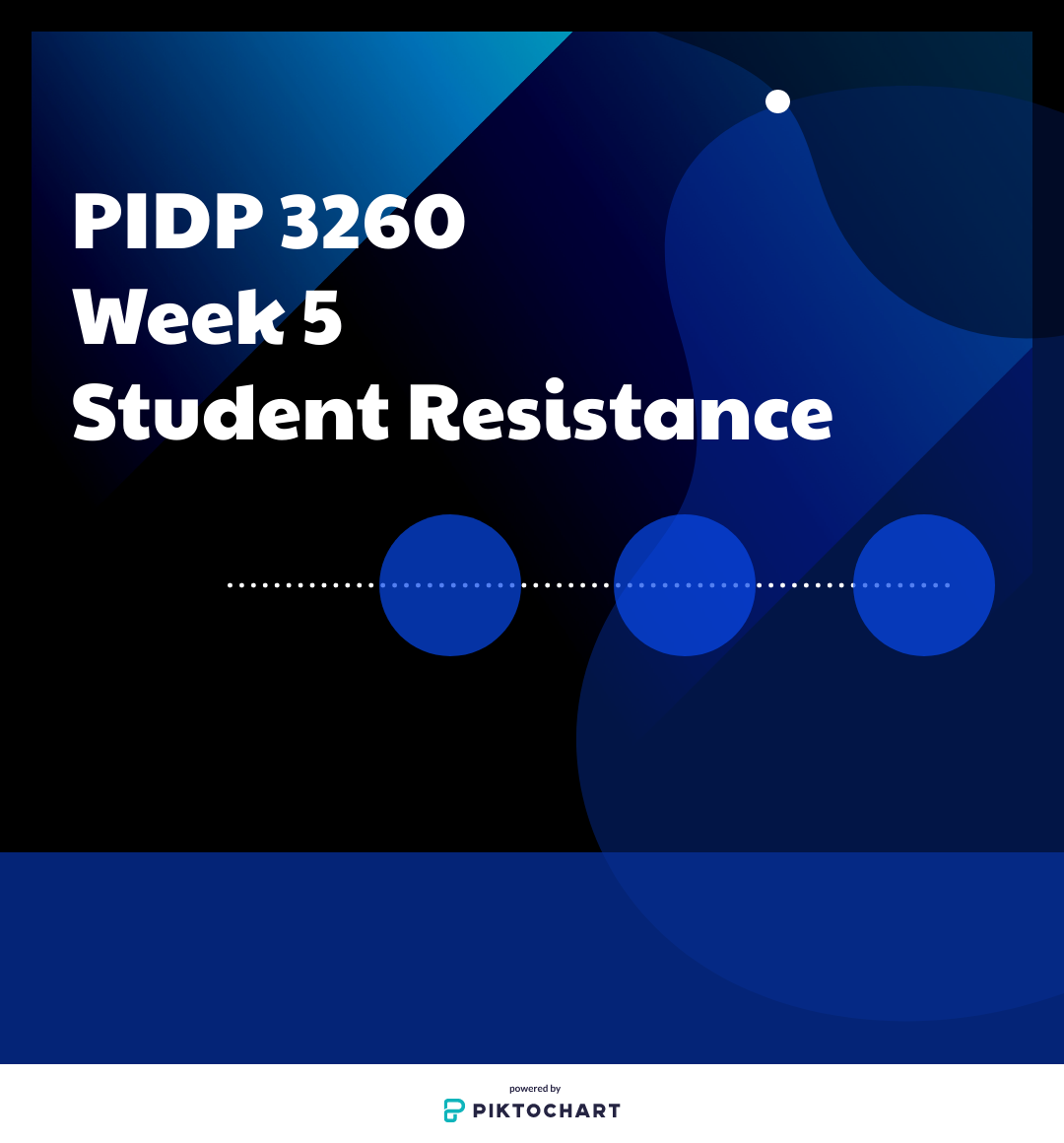PIDP3260 – Week 5 – Responding to Students’ Resistance to Learning


The key thing to understand about resistance in the classroom is not to assume it is you as the instructor that has created it. There are some students who feel entitled to pass or to receive a certain grade and others who if you let them chart their own path or become more involved in planning lessons, assume it is a sign that you don’t want to do your job (Brookfield 2015, Ch 17).
After all, according to Brookfield, students will often enter the first day of class with such resistance. It could be due to a variety of factors whether social-economic, or perhaps that they are mandated to take a class they do not like, or in some cases, students may be taking an entire program or degree because their family has asked that they do. In the same vein, it is just as important to remember that you cannot just remove the resistance like you would wash away a stain (Brookfield 2015, Ch 17).
It is also important to remember that the resistance is not always intentional or malicious. There are also times where the resistance is completely justified if in fact the instructor has failed to deliver on their promise to the students in terms of lessons or marking. This can especially be the case where there is not justification from the instructor on “why we’re doing things this way” and the instructor seems unqualified in the eyes of the students.

If students feel the subject or lesson is a waste of time, it is not likely to produce good results. It is also naive according to Brookfield (2015, Ch 17) that we can just “wave a magic wand” and correct the resistance and we have to accept that there will be cases where it is absolutely impossible to remove the resistance. Brookfield goes on to explain that there is often very little that we can do when someone has already predetermined that they don’t think there is any value in the course or subject. I will personally counter that sometimes this happens precisely as a result of an instructor not establishing credibility or explaining the value of the subject. However, if those things have been done then I will always revert to Brookfield’s assertions.
It is also not realistic in many cases that making a killer exercise or lecture is going to turn around those learns and Brookfield actually advises not to obsess over trying to convert the resistant.
The reasons why students are resistant to learning are so numerous we could almost write a book on it, but some of the common ones I’ve picked out is “fear of looking foolish” when they don’t want to learn something “too hard” and “too new”. Some students are also stigmatized as poor self-learners and simply need some more support and encouragement in my experience. Brookfield contends that sometimes students just don’t like a teacher on a personal level which may be out of the instructor’s control. To counter this, you should always make sure you are acting as a professional, engaging and listening to your students and anything beyond that may be an impossible barrier of bias or prejudice that cannot be overcome.
There are also legitimate concerns to the above, where if a teacher forces upon their cultural values of teaching upon a different culture, it is known as “Cultural Suicide” according to Brookfield.
In terms of the instructor being the cause of the resistance, if there is a lack of clarity in the instructions it can create frustration and animosity. Students may even blame the instructor if they don’t do well on the task or assignment.
With that said the question is now how do we respond? First we can try to sort things out by trying to learn the reason for the resistance, it could be that the course has a bad reputation, consult colleagues and most importantly talk to the students on an individual basis. Ask them what their concerns are and many times they will tell you and just as often you may be able to resolve their concern.
And finally by modeling the behavior and engagement that we expect as an instructor, you will also find you will get the same back in kind.
I believe resistant students are actually the minority and there are often reasons behind the resistance that can be overcome by just talking to the student and asking if they have concerns about the course or if anything outside of the classroom is impacting them inside the classroom. With a measured, professional, and diplomatic approach I believe that resistance can often be solved in the terms of my teaching environment at least.
References:
Brookfield, S. (2015). The Skillful Teacher: On Technique, Trust, and Responsiveness in the Classroom. San Francisco, CA: Jossey-Bass.





